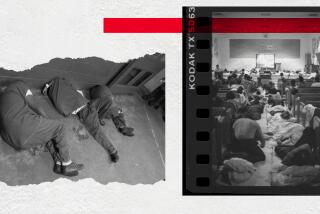Reservists’ Testimony Details Sleep Deprivation at U.S. Facility in Iraq
- Share via
CAMP PENDLETON — Three Marine reservists testified Friday that they were under orders to make Iraqi prisoners stand for hours so they would be exhausted and submissive when interrogated -- a practice the Marine Corps has since banned.
The three testified at the court-martial of Marine Sgt. Gary Pittman, who is accused of kicking and hitting Nagem Sadoon Hatab, a suspected hit man for Saddam Hussein, because he was unwilling or unable to stand. Hatab was a prisoner waiting to be interrogated at the Camp Whitehorse detention facility outside Nasiriyah.
Lance Cpl. Randall Herring, Lance Cpl. Angel Flores and Lance Cpl. Konstantin Mikholap testified that interrogators wanted prisoners subjected to the “50-10” treatment that required them to stand for 50 minutes each hour.
“They said keep them up 50 minutes and let them rest 10 minutes, and that’s what I did,” Flores said.
But two members of the corps’ elite interrogation squad -- called the “human intelligence exploitation team” -- have testified that they never gave such an order.
Though Herring, Flores and Mikholap said the 50-10 treatment was widely known, other guards have testified they never heard about it or saw it being applied.
“That 50-10 thing, I never heard about it,” testified one interrogator, whose name was not revealed for his own protection.
The testimony of another interrogator who denied using “50-10” appeared to contradict his earlier statements during a pretrial deposition in which he said sleep deprivation was useful in maintaining the “shock of capture” and making prisoners eager to provide information.
The question of who ordered the “50-10” treatment is key to the trial because prosecutors assert that when Hatab did not respond to repeated commands to stand up, Pittman became angry and attacked him. Hatab was handcuffed and hooded at the time.
Hatab, 52, died the next day; an autopsy found he had suffered six broken ribs and massive bruises.
Though the Whitehorse case and the scandal at the Army-run Abu Ghraib prison are different in most respects, they share this similarity: a confusion between jailers and interrogators over who had the authority to decide how roughly prisoners could be treated.
And amid that confusion at both places, alleged brutality took place that has resulted in high-level investigations and criminal charges.
Although he testified that guards were ordered to keep prisoners standing, Herring said most Marines, when confronted with prisoners who refused, let them remain on the ground.
Pfc. William Roy testified this week that Pittman hit Hatab with his fist and then with a karate-kick to the chest when he did not comply with a command to stand.
Roy, who was given immunity from prosecution, said he had earlier hit Hatab on the “meaty parts” of his arms and legs when the Iraqi refused to take off his clothes for a strip search.
Roy and Staff Sgt. Fredy Tellocastillo, the senior enlisted man at the facility, have testified it was common for guards to hit prisoners to make them follow commands. Other guards, however, said they never saw anyone strike a prisoner.
About 230 prisoners were brought to Camp Whitehorse during three months last year when the facility was run by a reserve battalion whose regimental headquarters is in Worcester, Mass.
After Hatab’s death, Maj. Gen. James Mattis, who was then commander of the 1st Marine Division, ordered a review of Marine Corps procedures for handling prisoners. Among other changes, sleep deprivation tactics, such as the “50-10” treatment, were banned and a 60-page manual delineating who has authority over prisoners was issued.
More to Read
Sign up for Essential California
The most important California stories and recommendations in your inbox every morning.
You may occasionally receive promotional content from the Los Angeles Times.













